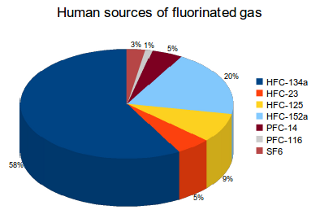Fluorinated gases are used inside of products like refrigerators, air-conditioners, foams and aerosol cans. Emissions from these products are caused by gas leakage during the manufacturing process as well as throughout the product's life. Fluorinated gases are also used for the production of metals and semiconductors.
Emissions of the three main fluorinated gases (hydrofluorocarbons (HFCs), perfluorocarbons (PFCs) and sulphur hexafluoride (SF6)) are almost all created by humans and are used mainly in industrial processes. With the exception of PFC-14 (CF4), fluorinated gases have no natural sources.
Human emissions have caused atmospheric levels to increase from near zero in 1750 to 89 parts per trillion (ppt) for HFCs and 6.7 ppt for SF6 in 2009. PFC levels have increased from 34.7 ppt in pre-industrial times to 82 ppt in 2009. For a long time now human activities have been creating fluorinated gas emissions much more rapidly than the Earth can remove them, increasing global levels.
Figure 1: Source: The 2010 Assessment of the Scientific Assessment Panel, UNEP.
Source: The 2010 Assessment of the Scientific Assessment Panel, UNEP.
Fluorinated gas emissions: HFCs
HFCs are the largest source of fluorinated gas emissions. They are also the fastest growing source of greenhouse gas emissions. Most HFCs are contained within equipment and products. Leakage of the gases causes emissions during manufacturing, maintenance as well as through regular usage. If disposal is not done properly, HFCs continue to leak out of the product until they are empty.
Table 1:
| HFC use | Percentage |
| Refrigeration and air-conditioning | 79% |
| Foams | 11% |
| Aerosols | 5% |
| Other (fire protection, solvents, etc.) | 5% |
Source: HFCs: A Critical Link in Protecting Climate and the Ozone Layer (2011), United Nations Environment Programme
Refrigerators and air-conditioners are the most important source of HFC emissions. These devices use HFCs as a coolant, which leaks out slowly over time. Commercial refrigerators, like those used in supermarkets, release substantial amounts of HFCs with emission rates from 5%-22% per year.
Mobile air-conditioners (MAC) used in cars and other vehicles are the systems that are responsible for the largest amount of HFC emissions. This is a combination of there being a large amount of these devices installed in vehicles around the world (80% of passenger cars and commercial vehicles) and their high rate of coolant loss. The annual emission rate of MAC systems is approximately 8%, which leads to large refrigerant losses after 5 years of at least 40%.
Foams are a significant source of HFC emissions. These gases are used during the production of foams as blowing agents. HFCs create the tiny bubbles in foams but are then trapped inside the material, emissions can then be released at any point, from manufacturing to disposal.
HFC emissions are also produced by aerosols. HFCs are used as propellants in aerosol sprays to create a mist of liquid particles. So each time the spray is used, it also releases these gases directly into the atmosphere. Other smaller sources exist like fire protection and solvents.
HFC-134a, HFC-23, HFC-125 and HFC-152a account for the majority of HFC emissions. HFC-134a is used in refrigeration and air-conditioning with emissions equal to 149000 tonnes annually. HFC-23 is emitted as a byproduct during the production HCFC-22. HFC-23 emissions equal 8700 tonnes annually. HFC-125 is also used in refrigeration and air conditioning with emissions equal to 22000 tonnes annually. HFC-152a is used as a foam-blowing agent and in aerosol spray applications with emissions equal to 50000 tonnes annually.
Fluorinated gas emissions: PFCs
PFCs are a significant source of fluorinated gas emissions. These gases are created during the production processes of aluminum and semiconductors. PFC-14 (CF4) and PFC-116 (C2F6) account for the majority of PFC emissions.
CF4 and C2F6 emissions are sometimes created as a byproduct of the aluminum smelting process. This is caused by disruptions like when alumina levels are too low. The aluminum industry produces 12000 tonnes of CF4 and 900 tonnes of C2F6 annually, making it the largest source of PFC emissions.
C2F6 is also used directly as an etchant and cleaner in semiconductor manufacturing. The portion of the gas that does not react with the materials during the process is usually released into the atmosphere. C2F6 emissions from this industry creates 1800 tonnes annually.
Less than 0.1% of total PFC emissions is caused by natural sources. Small amounts of CF4 are found in fluorite, granite and natural gas deposits. Geochemical reactions in the lithosphere cause these emissions. Natural sources are estimated to produce 10 tonnes of CF4 annually.
Fluorinated gas emissions: SF6
SF6 is another significant source of fluorinated gas emissions. This gas is mainly used by the electric power industry as an insulator and arc interrupter. The other important source of SF6 emissions is from its use as a cover gas in magnesium production. Total SF6 emissions equal 7160 tonnes annually.
SF6 is used extensively in equipment for the transmission and distribution of electricity. Emissions occur through leakage and maintenance losses. SF6 is also used as a cover gas to protect molten magnesium from oxidation. Emissions are caused during the production process when the gas is released into the atmosphere.
More info:
F-gases Emissions - US EPA
Fluorinated greenhouse gases - European Commission

